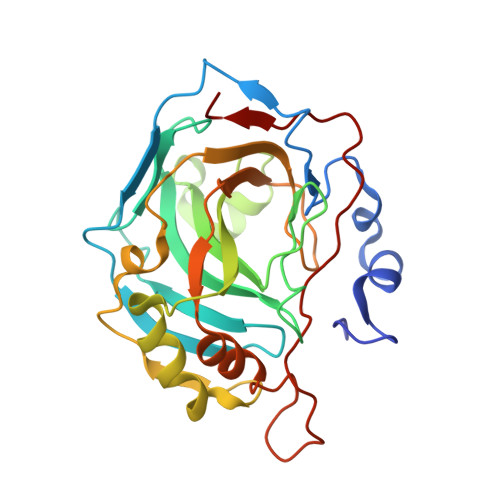Discovery of Potent Dual-Tailed Benzenesulfonamide Inhibitors of Human Carbonic Anhydrases Implicated in Glaucoma and in Vivo Profiling of Their Intraocular Pressure-Lowering Action.
Fares, M., Eldehna, W.M., Bua, S., Lanzi, C., Lucarini, L., Masini, E., Peat, T.S., Abdel-Aziz, H.A., Nocentini, A., Keller, P.A., Supuran, C.T.(2020) J Med Chem 63: 3317-3326
- PubMed: 32031797
- DOI: https://doi.org/10.1021/acs.jmedchem.9b02090
- Primary Citation of Related Structures:
6UFB, 6UFC, 6UFD - PubMed Abstract:
The design of three dual-tailed sulfonamide series 11a-11g , 14a-14h , and 16a-16e as carbonic anhydrase (CA, EC 4.2.1.1) inhibitors are presented. All compounds were evaluated for inhibitory action against pharmacologically relevant human CA isoforms I, II, IV, and VII. Compounds 11a-11g emerged as potent CA inhibitors against the four tested isoforms with a significant selectivity to CA II, which is implicated in glaucoma ( K i in the range 0.36-6.9 nM). X-ray crystallographic analysis of three compounds ( 11a , 11d , and 11g ) bound to CA II showed the validity of the adopted drug design strategy as specific moieties within the ligand structure interacted directly with the hydrophobic and hydrophilic halves of the CA II active site. Compounds 11b - 11d and 11g were evaluated for their intraocular pressure-lowering effects in a rabbit model of glaucoma. 11b and 11d showed significant efficacy when compared to the clinically used drug dorzolamide.
Organizational Affiliation:
School of Chemistry & Molecular Bioscience, Molecular Horizons, and Illawarra Health & Medical Research Institute, University of Wollongong, Wollongong, NSW 2522, Australia.


















